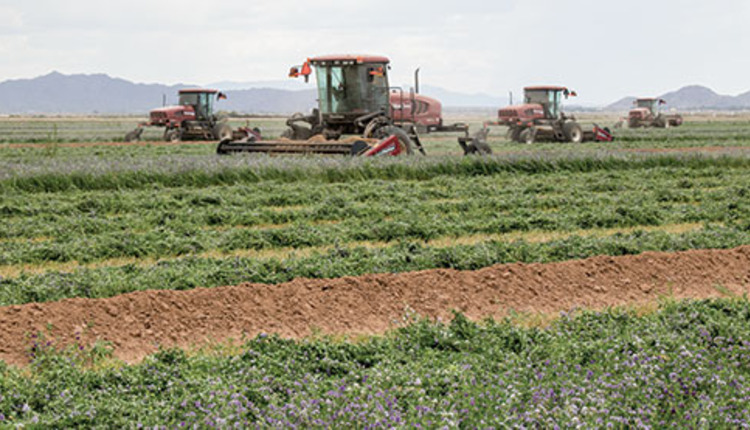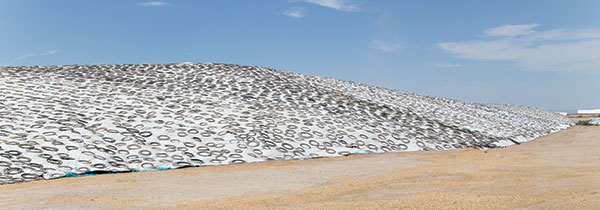
The dairy and supporting land base is owned and operated by the Dugan family — father Tom, and sons Tommy, Tony and Tim. Each oversees a component of the operation. Tom manages the dairy, Tommy oversees crop harvesting and manure management, Tony is the crop manager, and Tim is in charge of the extensive calf-raising facilities that amount to a small city of calf hutches. The farm currently employs about 400 full- and part-time people.
Doctor’s orders
Why would a family choose to milk and produce feed for thousands of cows in the middle of a desert where annual rainfall is about 8 inches and summer temperatures reach triple digits on a routine basis?
It was a matter of necessity for the Dugan family. The original family farm was located in east central Wisconsin. In 1962, Tom’s father was told he needed to move to a more arid region for health reasons. Originally, the family began milking 39 cows near Chandler, Ariz., but eventually urban sprawl pushed them south to the current location. At the time, much of the land had been used to grow cotton, and the soils were void of the fertility needed for alfalfa and corn.
Through the years, land improvements have been made and acreage has been added. More than 20,000 acres of mostly flood-irrigated forages, spanning 20 square miles, are grown today. Water is more expensive and less available than years gone by, but Arizona has had water management planning for many years and seems to be in a better place than some of its neighboring states.
Says Tommy, “We’re not really much different than farmers in the Midwest except they go to church and pray for rain, we just pay for it.”
The alfalfa enterprise is impressive. Fields are flood-irrigated once per cutting cycle. Over 12,000 acres are cut from nine to 12 times per year.
“The cutting intervals vary with the season,” says Tommy. “In the summer, we’re cutting about every three weeks. It’s more difficult to get high quality this time of year (July). With the heat, fiber levels are high and the plant matures really fast.”
During the winter, cutting intervals extend to about 45 days. Alfalfa is chopped, baled and sometimes direct-cut (fed as greenchop) in the winter. Fields are rotated to corn after three production years.
Alfalfa is direct seeded anytime from September to early December depending on the year and field conditions. Fall dormancy eight or nine varieties are used and seeded at a rate of 30 to 35 pounds per acre. Prior to establishment, about 20 tons of dairy manure is applied to fields. Most all of the manure is dry (a big advantage of desert dairying), and with 800 feet between ground level and the water table, the chances of groundwater contamination are remote.

Nonstop forage activity
Tommy’s job of harvest coordinator is not one for the weak of heart. Multiple fields and sometimes crops are being harvested simultaneously on any given day. That was the case when Hay & Forage Grower visited this past summer on a cool 108°F day; corn silage was being chopped at the same time alfalfa was being cut.
As most forage producers know, timeliness is everything when it comes to producing high-quality forage. To that end, the machinery line at T & K Red River Dairy is extensive: 15 16-foot MacDon swathers, 12 large square balers, nine Darf wheel rakes and 12 Claas forage harvesters provide the backbone. An army of trucks for hauling forage from field to farm compliments the harvest equipment. Several self-propelled, self-unloading harvest wagons have been special-built by a local machine shop for winter harvesting when fields are wet and more prone to compaction. Most of the forage is stored in large, drive-over piles.
Corn silage is the other major feed source produced by the dairy. The farm harvests about 9,000 irrigated acres annually. The silage pile had just been completed when Hay & Forage Grower was there; in total, 135,754 tons. Corn is planted in early March using hybrids in the 118-day relative maturity range. “We like to harvest at 68 to 72 percent whole plant moisture,” notes Tommy. “This year we averaged 32.1 tons per acre.”
It would seem that producing feed for 11,000 cows would be enough, but the Dugan family also has an alfalfa hay export business. They sell about 13,000 tons of hay to overseas buyers each year.
This article appeared in the January 2016 issue of Hay & Forage Grower on page 8.Not a subscriber? Click to get the print magazine.
